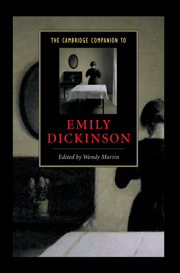1 - The Emily Dickinson wars
from Part 1 - Biography and publication history
Published online by Cambridge University Press: 28 May 2006
Summary
We see - Comparatively -
The Things so towering high
- Emily Dickson“There was a 'war between the houses,'” wrote Mary Lee Hall of the disputes between Lavinia Dickinson (Emily Dickinson's sister), Susan Gilbert Dickinson (Dickinson's intimate friend and the wife of her brother, Austin Dickinson), and Mabel Loomis Todd (Austin's lover for thirteen years) over the first volumes of Emily Dickinson's Poems and Letters edited and published by Todd and Thomas Higginson in the 1890s. This early and primarily female “war,” which “had as its site and center the volcanic and transgressive love relationship between Dickinson and Sue,” has continued into the present with disputes between male editors such as R. W. Franklin and feminist critics such as Susan Howe over the proper editing of Dickinson; the 1993 publication of New Poems of Emily Dickinson, edited by William H. Shurr, proposes to add 498 “new” poems to the Dickinson canon; and the 1998 publication of Franklin's long-awaited and already much-debated variorum edition of The Poems of Emily Dickinson adds seventeen poems to the Dickinson canon and promises to replace the standard edition of The Poems of Emily Dickinson edited by Thomas H. Johnson in 1955. As Christopher Benfey observes, “For a century now . . . the editing of Emily Dickinson's poetry has been entangled with human passions, sex, and blindered partiality, as though the editors were (and sometimes they were) . . . despairing lovers tossing on their beds.” This is the stuff of American soap opera. And yet these ongoing Dickinson wars have produced a heady mix of sex and text that has left its mark not only on past and recent editions of Dickinson's work but also on the making of American literary history.
- Type
- Chapter
- Information
- The Cambridge Companion to Emily Dickinson , pp. 11 - 29Publisher: Cambridge University PressPrint publication year: 2002
- 7
- Cited by



